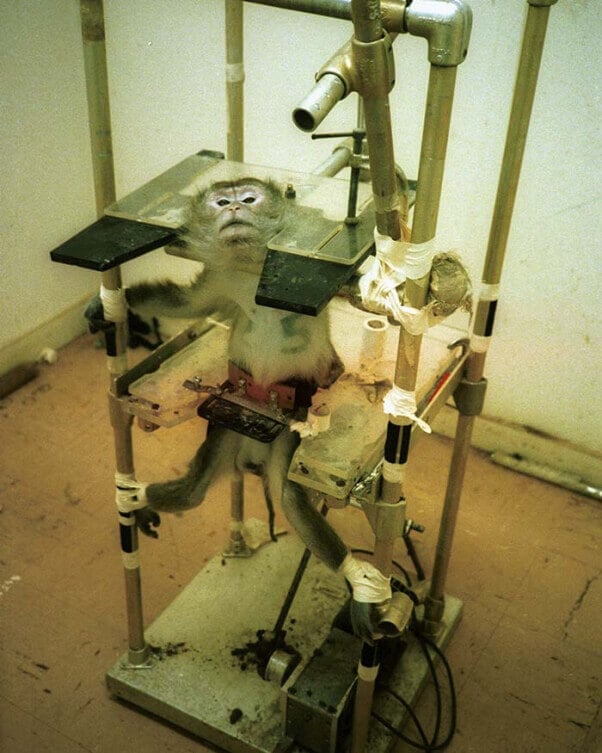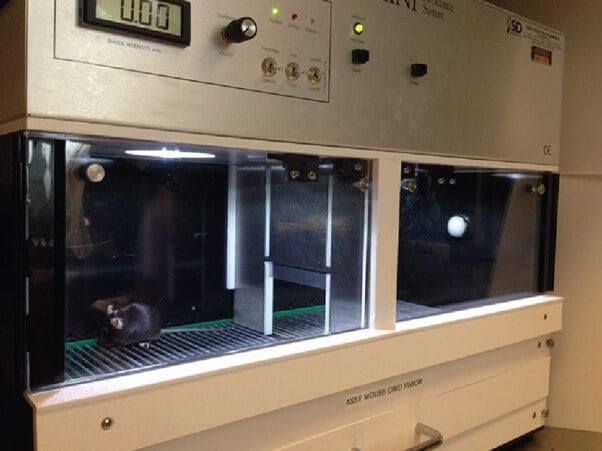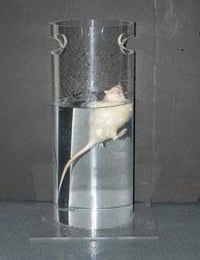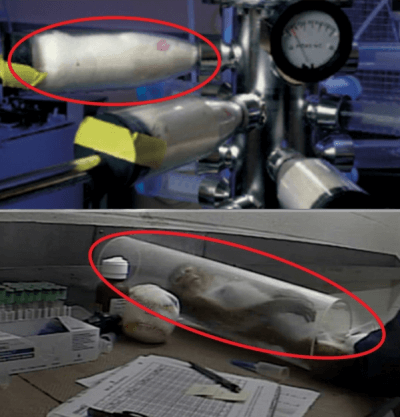10 Animal Torture Devices Straight From Your Nightmares
Right now, millions of mice, rats, rabbits, primates, cats, dogs, and other animals are locked inside cramped, barren cages in laboratories across the country. They languish in pain, ache with loneliness, and long to roam free and use their minds. Instead, all they can do is sit and wait in fear of the next terrifying and painful procedure that will be performed on them.
But what do these animals actually go through? While you might think that the devices described below are straight from the set of a horror movie, these 10 devices are actually being used in torturous and excruciating experiments on animals in laboratories across the country right now:
1. Rodent Guillotines
Tens of millions of mice and rats are killed each year in U.S. laboratories after they’re used in cruel and crude experiments in which they’re poisoned, electro-shocked, cut open in experimental surgeries, burned, and infected with disease. Experimenters commonly use rodent guillotines to cut off the heads of these small, sensitive animals. Such painful and gruesome beheadings seem out of place in the 21st century, but they’re business as usual in laboratories.
2. Stereotaxic Devices
Imagine having your whole body, including your head, held entirely immobile in a stainless-steel, vise-like contraption. Using a stereotaxic device, experimenters restrain mice, rats, cats, dogs, monkeys, and other animals, often while they’re fully conscious.
3. Restraint Chairs

Restraint chairs are used to hold monkeys in a seated or an upright position—for hours at a time—with clamping attachments around their neck and waist. They suffer from extreme emotional stress and painful physical injuries, including ulcers, rectal prolapse, and cuts or other wounds to their limbs. Monkeys are sometimes locked into restraint chairs as part of training exercises—after being electrically shocked or deprived of water for hours, they’ll “cooperate” with the experimenters to avoid additional painful shocks or in exchange for a few drops of water.
4. Metzenbaum Scissors
Nearly 66,000 dogs are tormented every year in U.S. laboratories. In some, experimenters who are tired of hearing the barking of agonized dogs will sever their vocal cords, eliminating the noise but not the animals’ distress. Animals in laboratories are locked inside cages, powerless to exercise any control over their lives, and when dogs are “debarked,” they lose even the power to express their anguish.
5. Carbon Dioxide Chambers

Rodent CO2 Euthanasia | Jacqueline Newell-Hunt | CC BY 4.0
These gas chambers subject mice, rats, and other animals to a crude and terrifying death once they’re no longer of use to experimenters. Carbon dioxide gassing is used on tens of millions of rats and mice in laboratories every year, even though exposure to high concentrations of carbon dioxide can cause extreme burning pain in their nose, throat, and chest. At a certain level, mice and rats experience difficulty breathing and a sensation akin to conscious drowning.
6. Shuttle Boxes and Shock Plates
 Dogs, mice, rats, and other animals are forced into or onto these small electrified boxes and plates in cruel psychological experiments and are repeatedly shocked in order to make them hopeless, terrified, and depressed. These nightmarish experiments can go on for days or even weeks—subjecting these animals to hundreds of painful electrical shocks.
Dogs, mice, rats, and other animals are forced into or onto these small electrified boxes and plates in cruel psychological experiments and are repeatedly shocked in order to make them hopeless, terrified, and depressed. These nightmarish experiments can go on for days or even weeks—subjecting these animals to hundreds of painful electrical shocks.
7. Forced Swim Tank

Like shuttle boxes and shock plates, forced swim tanks are designed to make mice and rats anxious and depressed. Experimenters force these animals into small beakers or large pools with a concealed depth. The animals are then forced to swim for their lives and are only plucked from the water once they give up, become resigned to death, and begin to drown.
8. Restraint Tubes

Mice, rats, and even monkeys are shoved into narrow hard-plastic tubes in which they are completely frozen in place and remain helplessly bound as the experimenters roughly force needles into their tails and legs or else force them to inhale noxious chemicals, compounding their terror.
9. Electroejaculation Devices
With crude and invasive instruments—like this one used on howler monkeys—rats, mice, and other animals are repeatedly anally probed as experimenters run electrical currents through their bodies, forcing them to ejaculate.
10. Collars and Poles
In laboratories, many monkeys have a tight-fitting metal collar permanently affixed around their necks. When these animals need to be moved, experimenters latch a long metal pole to the collar and violently hoist them up. Suspended by their necks, these terrified monkeys are yanked from their cages and slammed into a restraint chair or a transport cage or onto an examination table. Despite the high level of stress and potential for injury associated with these crude devices, the use of collars and poles, which are manufactured and sold by large primate dealers such as Primate Products, Inc., is still common in laboratories across the U.S.
Urge officials to shut down Primate Products, Inc.
Help stop animal tests!
As you read this, mice, rats, cats, dogs, birds, rabbits, monkeys, and other animals are suffering in cruel medical experiments and product tests. They suffer and die alone and in pain, without a gentle touch or a soothing voice. Because of the many differences between humans and other animals, findings from experiments on animals often are not applicable to humans. Testing on animals is simply bad science.
Speak up for animals today:






